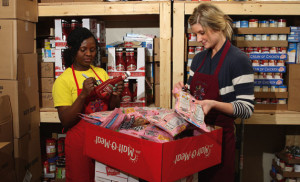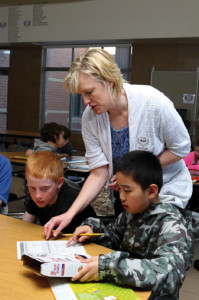One-third of all children and adolescents in the United States are overweight or obese. In South Dakota, 32.5Â percent of children ages 5 to 19 are overweight or obese. Among Native American children in the state, that number is 48.1 percent.

Transdisciplinary obesity prevention graduate certificate program students Celine Kabala and Alyssa Koens prepare donated food items to be given to those who eat at the Brookings Harvest Table.
Combating this childhood obesity epidemic will require the skills of a wide range of experts, says assistant professor of health and nutritional sciences Jessica Meendering.
To accomplish this, Meendering and her team are collaborating with the University of Nebraska-Lincoln to offer a Transdisciplinary Childhood Obesity Prevention graduate certificate program, referred to as TOP.
Networking with professionals
“Our goal is to have people think more broadly about obesity than nutrition and exercise,†says Meendering, who is SDSU’s principal investigator. The program brings together experts in a variety of disciplines including nutrition, exercise science, early childhood education, statistics, nursing, family development and counseling.
Development of the TOP graduate certification program, which began in 2011, is supported by a five-year, $4.1 million grant from the Agriculture and Food Research Initiative. This is part of the U.S. Department of Agriculture’s effort to prevent childhood obesity, educate youth about proper nutrition and connect experts and communities.
Meendering calls it, “bringing people together to work towards one common goal — to solve the problem.†In the past, professionals believed that teaching people how to exercise could solve the problem of obesity, says the exercise scientist.
“That’s really not how it works,†Meendering says. “It’s bigger than just your own discipline.â€
Others on the SDSU team are Extension associate and grant coordinator Becky Jensen; professor Kendra Kattelmann and associate professor Elizabeth Droke, both of health and nutritional sciences; associate professor Howard Wey of nursing; assistant professor Mary Bowne of teaching, learning and leadership; and Suzanne Stluka, food and families program director for Extension.
Emphasizing experiential learning

At the Camelot Intermediate School in Brookings, Adam Stauffacher and Leon Sun, examine nutritional facts listed on some common cereals and snack foods as part of the KidQuest Program, taught by Extension associate Becky Jensen.
The program has three components: education, research and service, referred to as experiential learning. Graduate students must take at least nine credits of child obesity prevention coursework to qualify for the graduate certificate.
Faculty at the two universities work together to teach the classes, Meendering explains. SDSU leads the fall class, while University of Nebraska-Lincoln handles the spring course. The students meet face-to-face at each university, and then the two groups interact using technology during the class. In addition to SDSU and UNL, students from the University of Nebraska-Kearney participate in TOP courses.
Of the 26 students enrolled in the program, 18 are from SDSU. Eight TOP students will graduate at SDSU this year.
The most unique aspect of the program is the emphasis on learning through community engagement. That’s where Jensen’s role in Extension comes in, providing experiential learning opportunities through interactions among the students and community members.
“This allows the students to take something that is novel and innovative from research,†Jensen says, and develop an effective program based on these principles.
For instance, graduate students Celine Kabala, Alyssa Koens and Megan Lauseng became involved with the Harvest Table, a nonprofit organization that serves a weekly no-cost meal to those in need in Brookings.
One of the biggest challenges at the Harvest Table is how to take a normal recipe and convert it to feed 150 to 175 people, explains Droke, who is in charge of this experiential setting. In addition, the students are incorporating more fruits and vegetables into traditional meal ideas.
The students will create a notebook of resources for the Harvest Table that will address scheduling, food safety, menu ideas with quantity resources and safe handling of leftover food.
“This experience makes the students aware of the situation of food insecurity for people in the community,†says Vonda Kirkham, director of the Harvest Table, explaining that many of these folks do not have enough money to buy the food they need.
“This is a good way for us as a department and a program to get connected with the community,†Droke says.
In addition, Stluka has spearheaded another avenue for experiential learning to help communities create a sustainable wellness plan specifically tailored to their needs through the formation of wellness coalitions, a diverse group of community members with a vested interested in promoting wellness within their communities.
Four TOP students will work on implementing the first wellness coalition this fall in southwestern South Dakota.
Improving students’ skills, marketability
“These students get a lot of real-world experience working in teams with people from other disciplines,†explains Meendering. And the TOP students agree that networking will help them in their careers.
“It’s all about marketability, anything that can increase your list of skills is always a plus,†says Emily Huber. As an undergraduate, Huber worked with the KidQuest program, which teaches preadolescents healthy eating habits. She is now continuing that work while pursuing a master’s degree in nutrition, exercise and food science that includes TOP certification.
For her thesis, Huber will determine whether participating in KidQuest has affected the physical activity levels of 400 fifth- and sixth-graders. The children in the study wore belts equipped with accelerometers during waking hours for seven days before and seven days after they completed the coursework.
The accelerometers provide an objective measure of physical activity, Huber says, “tracking not just the number of steps they take but how fast they are moving and how long they spend at different intensity levels.†She will analyze the data for her thesis.
Graduate students Kabala and Koens, who worked with the Harvest Table, are evaluating the impact of i-Cook 4-H, a program that teaches low-income families and their children how to make meals that contain the proper balance of fruit, vegetables, whole grains and lean meat on a limited budget.
The pilot program, which is aimed at 9- and 10-year olds, is being tested in five states—South Dakota, Nebraska, Tennessee, West Virginia and Maine, through a five-year USDA grant. Nutrition expert Kattelmann supervises their work.
“As dieticians, we usually look at physical activity and nutrition and a little bit of genetics,†says Kabala. “Through this program, we learn about different angles that contribute to childhood obesity.â€
Graduate student Megan Olesen agrees: “This problem can’t be tackled by one discipline; we need approaches from all sides.†She worked with graphic design students and the Jackrabbit mascot to explore how social marketing can promote healthy eating and exercise habits among area fourth-graders through a program called Jumpin’ Jacks.
These students have learned an important lesson, grant coordinator Jensen says, “they have to reach out.â€Â Realizing the value of collaboration among disciplines early in their careers will make these TOP students more effective professionals.â€
Christie Delfanian






